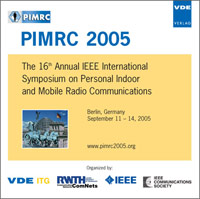OVSF Code Allocation and Two-stage Combining Method to reduce Inter-code Interference in OFCDM System
Conference: PIMRC 2005 - 16th Annual IEEE International Symposium on Personal Indoor and Mobile Radio Communications
09/11/2005 - 09/14/2005 at Berlin, Germany
Proceedings: PIMRC 2005
Pages: 5Language: englishTyp: PDF
Personal VDE Members are entitled to a 10% discount on this title
Authors:
Hasegawa, Kazuhiko; Shimura, Ryuichiro; Ohno, Tsutomu; Yoshimochi, Naoki; Sasase, Iwao (Dept. of Information and Computer Science, Keio University, Yokohama, Kanagawa, Japan 223-8522)
Abstract:
In this paper, we propose an OVSF code allocation at a base station and a two-stage combining method at a receiver to reduce inter-code interference in OFCDM system. In the proposed OVSF code allocation, OVSF codes which have different ancestor codes are allocated to users. If allocated codes are divided into chips shorter than spreading factor, chips which are produced by each allocated codes are orthogonal. In the two-stage combining method, the allocated code is divided into chips and received symbols are despread using chips. Demodulated symbols are produced from the despreading, multiplied by weights, and combined. The combining method of the proposed scheme has two stages. The first stage is the despreading, and the second stage is the weight combining. The proposed scheme uses few sub-carriers among which a difference of amplitude levels is small at the despreading, and combines demodulated symbols at the weight combining using suitable weights. Thus, the proposed scheme can reduce inter-code interference. We show that the proposed scheme achieves better BER performance than the conventional scheme by computer simulations.


